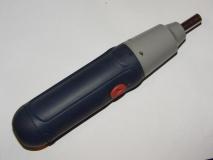
Cheap electric screwdriver
Many instruments are needed once per a long time (e.g. for winding coils, capacitors, or operating a glass lathe or a ball mill), and require a power unit to spin them up. Having a dedicated motor in each one is a waste of resources, as the motors and the gearboxes are fairly costly. A power unit that can be easily added/removed and can be shared between several devices is therefore called for. A 1/4" hex shank, the same as the screwdriver bits use, is a very convenient coupling mechanism for rapid attach/detach of the unit.
A cheap electric screwdriver was obtained; so cheap that it does not even have a built-in rechargeable battery and uses four AA-cells instead. It probably eats them faster than a German antiaircraft gun consumed shells during the Berlin bombing raids.
 Cheap electric screwdriver |
The screwdriver was disassembled. The grey part that houses the gearing (plastic and noisy, but good enough for a prototype test) was coupled to the blue part with the motor and batteries with a pair of steel pins pressed into holes through both parts. The pins were pushed out, the gray part pulled off, and the two halves of the blue shell taken apart. This exposed the motor and its ingeniously (or atrociously, your pick) simple switch and direction selector.
 Disassembled electric screwdriver |  Disassembled electric screwdriver |  Disassembled electric screwdriver |  Motor, battery contacts and switch |
 Motor, battery contacts and switch |  Motor in place |
The battery housing (not shown, with output contacts mating to the switch contacts) was removed. The direction selector/switch was removed from the motor.
A three-position DPDT switch was placed next to the motor, for direction control. Initially the motor contacts were soldered directly to the switch terminals, but later short pigtails of stranded wires were added to allow moving the motor aside without unmounting the switch.
The device is intended for prolonged operation, so an external power supply was required. A standard
approach with a 5.1mm barrel jack and a 12 volt wall-wart was chosen as nearly everything else
is standardized around this already.
As the power supply, a buck converter with a LM2576 chip was chosen. The motor consumes
up to 2.5 amps at 6 volts, so a higher-efficiency solution than a linear regulator was
required in order to minimize waste heat. A heatsink was made from a length of aluminium
profile, a 20x10mm asymmetric L. (A 15x15mm U was used during development, but then the
heatsink was protruding outside of the mounting frame, which could cause issues in the future.)
A potentiometer was used to regulate the output from 1.25 volts (about just enough to get the
motor moving with reasonable force) to almost the full input power (which seriously overloads
and overheats the motor, so it is advised against for longer time periods).
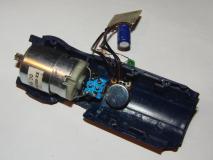 Direction switch, power supply |  Heatsink | 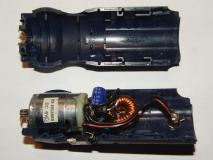 Power converter circuit in place | 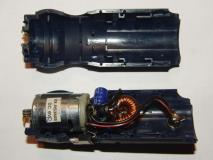 Power converter circuit in place |
 Circuitry in place |  Circuitry in place |  Circuitry in place |  Control panel |
 Control panel |
To couple it easily with the devices to be powered, the unit is mounted on an L-shaped steel plate with 20x20 mm raster of 5 mm holes (standard carpentry joining plates, inexpensive and readily available). The shaft of the screwdriver has diameter just below 10 mm; a 10 mm hole was therefore drilled into the face plate of the L part.
The holes for the steel pins, which held the motor and gear together, were redrilled to 3.2 mm diameter and long M3 screws were placed through them. (M5 screws were considered but it turned out that there is not enough material in the blue parts to hold them in safely.)
A pair of M5 long joining nuts was chosen as standoffs. Portions of them were ground off with an angle grinder to mate the curved body of the screwdriver housing. A line of holes was drilled into the L-plate, to allow multiple protrusion lengths of the powered shaft, from almost full to being flush with the plate. The hole in the plate serves as the third point to hold the screwdriver in position. Rubber gaskets are placed under the standoffs, to suppress vibrations and compensate for small excentricities of the gears and the coupled shafts.
The L-plate can be used for easy mating of the power unit to other devices, especially if they are built from similar plates. The fairly accurate positions of the holes turn them into a heavy-duty construction set.
 Assembled unit, mounting plate |  Assembled unit, mounting plate |  Assembled unit, mounting plate, front | 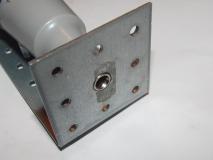 Assembled unit, mounting plate, front |
 Assembled unit |  Assembled unit |  Assembled unit |